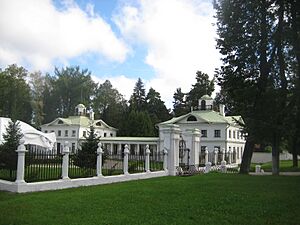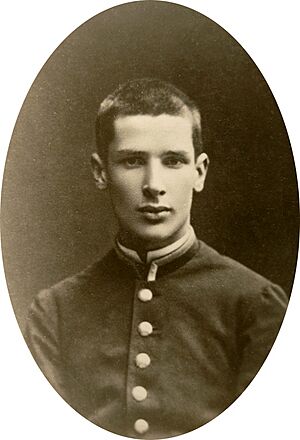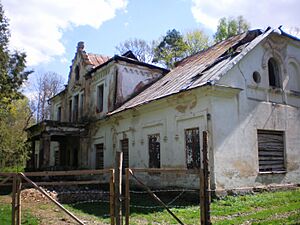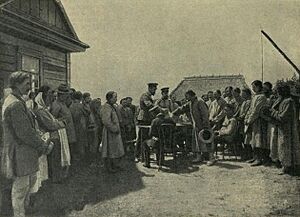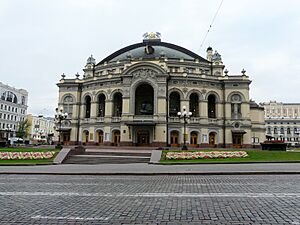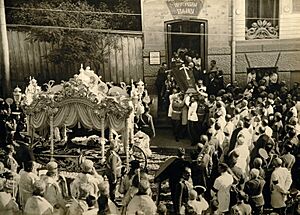Pyotr Stolypin facts for kids
Quick facts for kids
Pyotr Stolypin
|
|
|---|---|
| Пётр Столыпин | |
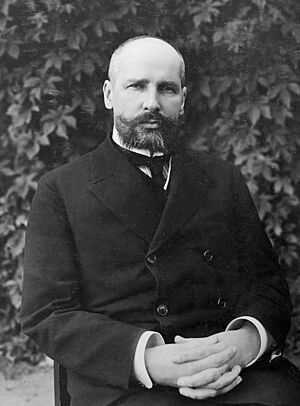 |
|
| 3rd Prime Minister of Russia | |
| In office 21 July 1906 – 18 September 1911 |
|
| Monarch | Nicholas II |
| Preceded by | Ivan Goremykin |
| Succeeded by | Vladimir Kokovtsov |
| Minister of Internal Affairs of Russia | |
| In office 26 April 1906 – 18 September 1911 |
|
| Prime Minister | Ivan Goremykin Himself |
| Preceded by | Pyotr Durnovo |
| Succeeded by | Alexander Makarov |
| Personal details | |
| Born |
Pyotr Arkadyevich Stolypin
14 April 1862 Dresden, Kingdom of Saxony, German Confederation |
| Died | 18 September 1911 (aged 49) Kiev, Kiev Governorate, Southwestern Krai, Russian Empire |
| Cause of death | Assassination |
| Resting place | Kyiv Pechersk Lavra, Ukraine |
| Nationality | Russian |
| Spouse | Olga Borisovna von Neidhardt |
Pyotr Arkadyevich Stolypin (Russian: Пётр Аркадьевич Столыпин, IPA: [pʲɵtr ɐrˈkadʲjɪvʲɪtɕ stɐˈlɨpʲɪn]; 14 April [O.S. 2 April] 1862 – 18 September [O.S. 5 September] 1911) was an important Russian leader. He served as the third prime minister and the interior minister of the Russian Empire. He held these roles from 1906 until he was killed in 1911.
Stolypin is remembered as a great reformer. His changes helped the Russian state grow a lot, especially its economy. This growth stopped when he was assassinated.
He was born in Dresden, in the Kingdom of Saxony, into a well-known Russian noble family. Stolypin started working in government when he was in his early 20s. He was very successful, which led to him quickly moving up in his career. In April 1906, he became the interior minister. Then, in July of the same year, he became prime minister.
As prime minister, Stolypin started big agrarian reforms. These changes, known as the Stolypin reform, gave peasants the right to own their own land. His time in office also saw a lot of protests and unrest. He responded by bringing in a new system of martial law. This allowed for quick arrests, trials, and executions of people accused of crimes. After several attempts on his life, Stolypin was shot and killed in September 1911 by a revolutionary named Dmitrii Bogrov in Kiev.
Stolypin believed in the power of the monarch (the Tsar). He wanted to make the Tsar's rule stronger by making the Russian countryside more modern. His main goals were to make things modern and efficient, not to create a democracy. He thought that land problems could only be solved, and protests avoided, if the old peasant commune system was ended. He wanted to create a stable class of land-owning peasants, called kulaks. These farmers would then have a reason to support the current system.
Historians still debate his successes and failures. However, they generally agree that he was one of the last major leaders of Imperial Russia. He had clear and strong ideas for public reforms.
Contents
Early Life and Government Career
Pyotr Stolypin was born in Dresden, Germany, on April 14, 1862. His father, Arkady Dmitrievich Stolypin, was a Russian diplomat at the time.
Stolypin's family was very important in the Russian aristocracy. His ancestors had served the tsars since the 1500s. Because of their service, they had gained huge land estates in many parts of Russia. His father was a general in the Russian army. He was also the governor of Eastern Rumelia and the head of the Kremlin Palace guard.
Pyotr grew up on the family estate called Serednikovo near Moscow Governorate. This estate was once home to the famous writer Mikhail Lermontov. In 1879, his family moved to Oryol. Stolypin studied at the Oryol Boys College. His teacher described him as "standing out among his peers for his rationalism and character."
In 1881, Stolypin studied agriculture at St. Petersburg University. One of his teachers was the famous chemist Dmitri Mendeleev. After graduating in 1885, he started working for the government. He wrote his final paper on growing tobacco in southern Russia.
In 1884, Stolypin married Olga Borisovna von Neidhardt. Her family was also very well-known, similar to Stolypin's. They got married while Stolypin was still a student, which was unusual back then. Their marriage was happy and without any scandals. They had five daughters and one son.
Time in Lithuania
Stolypin spent a lot of his life and career in Lithuania. At that time, it was known as the Northwestern Krai of the Russian Empire.
From 1869, Stolypin spent his childhood years at the Kalnaberžė manor. His father built this manor, and it remained Pyotr's favorite home for the rest of his life. In 1876, the Stolypin family moved to Vilna (now Vilnius). There, he attended grammar school.
Stolypin worked as a marshal in the Kovno Governorate (now Kaunas, Lithuania) from 1889 to 1902. This job helped him understand local needs. It also allowed him to develop strong leadership skills. He was influenced by the single-family farm system in the Northwestern Krai. Later, he tried to bring this kind of land reform, based on private ownership, to all of Russia.
His work in Kovno was seen as a great success by the Russian government. He was promoted seven times. In 1901, he became a state councilor. Four of his daughters were born during this time. His daughter Maria later said this was the "most calm period" of his life.
In May 1902, Stolypin was made governor of Grodno Governorate. He was the youngest person ever to hold this position.
Governor of Saratov
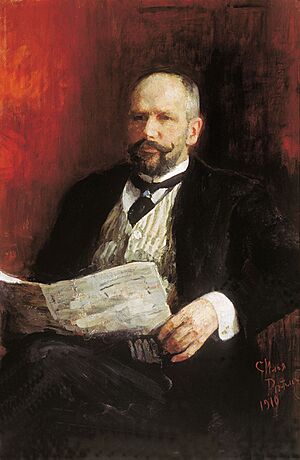
In February 1903, he became governor of Saratov. Stolypin became known for stopping protests by workers and peasants in January 1905. The peasants in Saratov were among the poorest and most rebellious in the country. He worked with the zemstvos, which were local governments. He gained a reputation as the only governor who could keep his province under control during the Revolution of 1905. This was a time of widespread unrest across Russia.
The problems partly came from the Emancipation Reform of 1861. This reform had given land to the Obshchina (peasant communes) instead of directly to the newly freed serfs. Stolypin was the first governor to use strong police methods. Some say he had police records on every adult male in his province.
Interior Minister and Prime Minister
Stolypin's success as a governor led to him becoming interior minister in April 1906. He worked under Prime Minister Ivan Goremykin. He also supported building a new part of the Trans-Siberian Railway. This new section would run along the Russian side of the Amur river.
After two months, Goremykin resigned. Tsar Nicholas II then appointed Stolypin as Prime Minister. Stolypin also remained the Minister of the Interior. He decided to dissolve the Duma (the Russian parliament). He did this to make way for cooperation with the new government.
On August 25, 1906, three attackers bombed a public event Stolypin was holding. This happened at his home on Aptekarsky Island. Stolypin was only slightly hurt, but 28 other people were killed. His 15-year-old daughter was badly injured and died later. His 3-year-old son broke a leg. After this, Stolypin moved into the Winter Palace.
Stolypin changed the rules for the Duma. He wanted to make it easier for the government's ideas to pass. On June 8, 1907, Stolypin dissolved the Second Duma. He also arrested 15 members who were linked to terrorists. He changed how votes were counted, giving more power to the rich and noble classes. This reduced the power of votes from lower classes. These changes affected the elections for the Third Duma. This new Duma had more conservative members who were willing to work with the government.
As governor in Saratov, Stolypin believed the old open field system had to go. He thought that communal land tenure (where land was shared) needed to end. So, breaking up the Mir (commune) (peasant community) and giving individual peasants their own land became the main goals of his farming policy. He brought in land reforms similar to those in Denmark. These reforms aimed to calm peasant unrest and stop disagreements.
Stolypin's reforms aimed to stop peasant unrest. He wanted to create a group of small farmers who owned their land and sold their crops. These farmers would then support the social order. He was helped by Alexander Krivoshein, who became Minister of Agriculture in 1908.
With help from the Peasants' Land Bank, credit groups grew rapidly from 1908. Russian industry was also growing fast. Stolypin tried to make life better for city workers. He also worked to increase the power of local governments.
The famous writer Leo Tolstoy was very upset by Stolypin's actions. He wrote to Stolypin, saying: "Stop your horrible activity! Enough of looking up to Europe, it is high time Russia knew its own mind!"
In 1910, Stolypin's land reforms became a formal law in the Duma. This included a plan to spread the zemstvo system to new areas of Russia. Even though the law seemed likely to pass, Stolypin's political opponents managed to defeat it. In March 1911, Stolypin resigned from the Duma after his land-reform bill failed.
The Moscow Times newspaper later summarized his work:
Pyotr Stolypin's reforms produced astounding results within a few years. Between 1906 and 1915, thanks to the efforts of Stolypin's farmers, the productivity of crops nationwide grew by 14 percent, in Siberia by 25 percent. In 1912, Russia's grain exports exceeded by 30 percent those of Argentina, the United States and Canada combined.
His Final Days
Stolypin traveled to Kiev even though police warned him about a plot to kill him. There had already been 10 attempts on his life. On 14 September [O.S. 1 September] 1911, Stolypin went to see an opera called The Tale of Tsar Saltan. He was at the Kiev Opera with the Tsar and his daughters. The theater had 90 guards inside.
After the second act, Stolypin was standing near the stage. His personal bodyguard had stepped out for a moment. A Jewish revolutionary named Dmitry Bogrov shot Stolypin. Bogrov tried to run away but was caught. Stolypin made a gesture to tell the Tsar to go back and then made the sign of the cross. He stayed conscious, but his condition got worse. He died four days later.
Bogrov was executed 10 days after the assassination. The official investigation was stopped by order of the Tsar. This led to ideas that the assassination was planned by people who opposed Stolypin's reforms. However, this has never been proven. Stolypin was buried in Kiev, the city where he was killed, as he had wished.
What People Remember
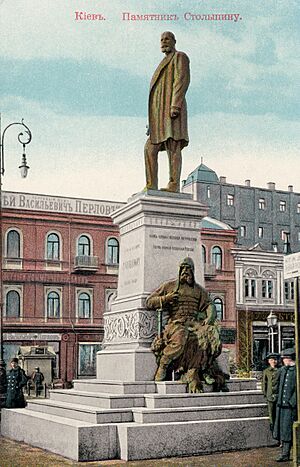

From 1905, Russia had many political problems and protests. Groups on the left side of politics used violence against the government. Many police officers and officials were killed across Russia. Stolypin would inspect troubled areas without weapons or bodyguards. Once, a bomb was dropped near him, causing injuries to others, but he survived.
To deal with these attacks, Stolypin created a new court system using martial law. This allowed for quick arrests and trials of accused offenders. Between 1906 and 1909, over 3,000 (and possibly up to 5,500) suspects were found guilty and executed by these special courts. The large train cars used to move people to new settlements in Siberia were even called Stolypin cars.
People have different opinions about Stolypin's legacy. Historians disagree on how realistic his policies were. Some approve of his strong actions to stop protests and chaos after the 1905 Revolution.
It is still debated whether his farming policy would have worked even without his murder and First World War. Many peasants were very traditional and slow to change. By 1914, the strip system (where land was divided into narrow strips) was still common. Only about 10% of the land had been combined into larger farms. Most peasants did not want to leave the safety of their commune for the risks of individual farming.
In 2008, a TV poll in Russia called "Name of Russia" asked people to choose "the greatest Russian." Stolypin came in second, after Alexander Nevsky and before Joseph Stalin. His supporters see him as the greatest leader Russia ever had. They believe he could have saved the country from revolution and civil war.
On December 27, 2012, a monument to Pyotr Stolypin was put up in Moscow. This was to mark 150 years since his birth. The monument is near the Russian White House, where the Russian government works. At the bottom of the monument, a bronze plaque quotes Stolypin: "We must all unite in defense of Russia, coordinate our efforts, our duties and our rights in order to maintain one of Russia's historic supreme rights - to be strong."
Screen Portrayals
Stolypin is played by Eric Porter in the 1971 British film Nicholas and Alexandra. He is also played by Frank Middlemass in episode 9 of the 1974 British miniseries Fall of Eagles.
See also
 In Spanish: Piotr Stolypin para niños
In Spanish: Piotr Stolypin para niños
- Coup of June 1907
- Stolypin reform


